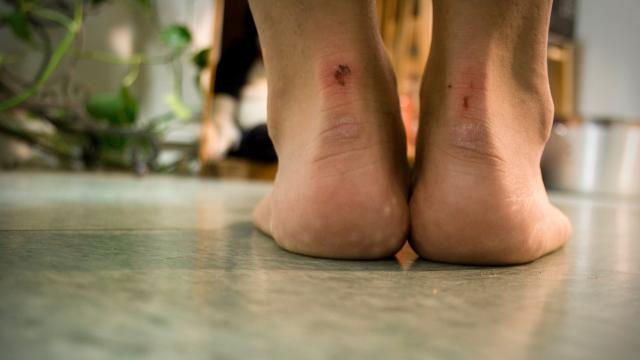You know you’re not supposed to pick a scab (right?). It turns out, though, that the real pro move is to avoid them in the first place, so by the time you’re sitting on your hands virtuously avoiding picking your latest scab, you’ve already blown it.
Photo by Caitlin Regan.
“The best scab is no scab,” says Dr Thomas Rohrer, a board-certified dermatologic surgeon and member of the American Academy of Dermatology in practice at SkinCare Physicians in Massachusetts. “Try to prevent them from forming.”
Where Scabs Come From
Say you eat a little pavement when you’re out for a jog in the park and your knee looks like a crime scene. Aside from the blood, the wound will secrete other oozy stuff such as growth factors, fibroblasts, and a new matrix for the skin, which, Dr Rohrer says, are the wound’s attempt at healing itself.
“If you just let it be, it dries up and seals it off, which is good in that it seals it from the environment,” Rohrer says, “but it actually slows the healing down.” When a wound dries out and becomes a scab, the new skin has to form under it, he says, which increases the chances of a depressed scar forming.
Scabs exist to form a clot to stop bleeding, and to serve as a protective barrier as new skin forms, says Dr Marc Glashofer, a board-certified dermatologist and skin cancer surgeon and member of the American Academy of Dermatology practising in northern New Jersey with The Dermatology Group.
How to Prevent Them
Instead of letting a wound scab over, after you cut yourself, clean it and cover it with a very plain ointment to keep it juicy, then bandage it up. Rohrer likes Vaseline – a neutral barrier without medication.
“The key is to keep it moist, but not too moist,” Rohrer says. “You don’t want it to get soupy.”
Shudder.
Glashofer also says to keep it moist, no matter what momma used to say about letting the wound air out. “This old adage is false and slows the healing process, and may lead to a higher chance of a more noticeable scar.”
Contrary to what’s definitely in your medicine cabinet or first aid kit, you don’t want to put a triple antibiotic on it. Rohrer says these well-loved remedies are actually prime suspects when it comes to skin allergies or irritation.
Glashofer says that wounds heal more slowly in smokers and diabetics, and that they take longer in everyone as we age. Wounds lower on the body heal more slowly than those on the face and neck.
Why We Pick
And what of that ultimate temptation, the disgusting habit of garbage people everywhere? Why must we pick?
“I guess the stock answer would be because it’s there,” says Rohrer. “We’re used to our skin being smooth. You want to return it to its natural state.”
Glashofer explains that as the wound heals, inflammatory cells show up to help fight off potential microorganisms and foreign material. Those, coupled with the scab drying out, make it itch.
“Picking or removing the scab will lead to a longer healing process,” he says, “and can increase chances of healing with a more noticeable scar.”

Comments
One response to “Why You Pick Scabs, And How Not To”
Extremely practical advice. Better buy some vaseline!